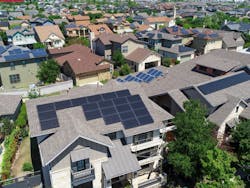Economics is Driving the Growth of Distributed Energy Resources in Texas
Texas was among those states in the 1990s to restructure its retail electricity market, which gave business and residential consumers the option to choose a power supplier. Today, that type of innovation is expanding to give those users more dynamic options — the ability to generate their own electricity with distributed energy.
The Texas Clean Energy Coalition and the Brattle Group say that customers are deploying rooftop solar panels or fast-starting natural gas micro-turbines while others are using energy efficiency and demand response. The study, titled “Valuing and Compensating Distributed Energy Resources in ERCOT,” notes that battery storage technology is also slowly becoming viable. ERCOT is the grid operator in Texas that oversees 85 percent of the state’s network.
“Economics is driving the rapid adoption of distributed energy resources in Texas,” says Elizabeth Lippincott, executive director of the clean energy group, in an interview. “The cost of these technologies is dramatically falling. We are moving away from the older less efficient coal burning plants and moving toward renewables. It is increasing customer choice” — the movement that began in the 1990s.
“We do have an open and market driven grid,” she adds. “That enables homeowners, businesses and larger-scale industrials to have more tools in their toolbox. Consumers can generate their own power and be in command.”
Distributed energy resources consist mostly of on site generation with microgrids and battery storage. Collectively, they defuse the central generation capacity and reduce carbon dioxide emissions.
According to the study, distributed energy resources grew by 62% between 2015 and 2017, within ERCOT. Today that figure stands at about 1,300 MW. ERCOT is able to gauge the amount of those resources because any distributed asset between 1 MW and 10 MW that exports power to the grid is required to be registered with the network manager. If it is less than 1 MW — solar rooftop panels, mostly — it does not have to be reported.
Distributed energy resources, including energy efficiency, is relieving the grid of congestion. The study is thus projecting a 13% fall in peak electricity demand between 2017 and 2031. That will invariably improve reliability and reduce emissions.
Reliability, indeed, is a major catalyst when it comes to deploying distributed assets, Lippincott says. Consider Hurricane Harvey that hit Houston in 2017: Those with microgrids powered by on site generation were able to keep the lights on during the storm, or to come back on quickly. And those places were used by first responders to keep the community safe.
The study says that distributed energy resources have a lot more room to grow, which can be reached if stakeholders evaluate time-variable pricing and improve price signals to help shift peak demand. And they need to evaluate a way to harness electric vehicle batteries as energy storage assets.
“Customers can expect to pay less for electricity as they sell power back to the grid, especially during peak periods,” Lippincott says, in a release. “In areas where there is reliance on wind and solar, distributed energy resources can also be deployed to help balance the grid and improve reliability. That’s a win-win for Texas.”
Learn more about distributed energy in Texas in “The Evolution of Distributed Energy Resources: What the Rise of Local Energy Means for Businesses, Institutions and Communities,” a Microgrid Knowledge special report, downloadable free of charge, courtesy of NRG Energy.








